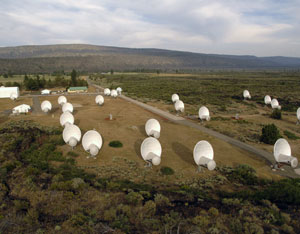

QUIETLY situated in a modernist building on Mountain View’s Whisman Road, a stone’s throw from the NASA Ames Research Center at Moffett Field, 130 scientists and staffers work at the only scientific organization worldwide dedicated to the search for extraterrestrial intelligence.
Founded in 1984, the SETI Institute is funded by government agencies and private supporters including Hewlett-Packard, Microsoft co-founder Paul Allen and Intel’s Gordon Moore. Seth Shostak, SETI’s senior astronomer and the author of Confessions of an Alien Hunter, says the group is accelerating its mission with the addition of its new Allen Telescope Array, located near the Lassen National Forest (and named after Paul Allen who kicked down the money to get it started).
SETI uses telescopes at Lick Observatory to look for flashing laser lights from space. SETI scientists also perform the analysis work for NASA’s Kepler Mission, which is seeking Earth-size planets, especially those in the habitable zone of their stars, where liquid water and life might exist. So-called “astrobiologists” at SETI’s Carl Sagan Center study how life began on Earth and the nature of life beyond earth.
These and other experiments, dating back to the 1960s, seeking signs of life in outer space have of course so far yielded nothing. Shostak is well aware that this silence has produced some skepticism.
“A lot of people say, ‘Doggone it, it’s been 50 years since the first SETI experiment, and we haven’t heard anything—and that must mean something,'” he concedes. However, Shostak says technological limitations have only allowed scientists to look for signals in about 750 star systems out of 200 or 300 billion. “That’s just like going to Africa, looking for elephants and giving up after looking at one city block’s worth of real estate,” he says.
It will take $35 million to get all 350 of the Allen Telescope Array’s antennae up and running. And when they do, Shostak says, he believes they’ll find ETs within 25 years because the ATA will speed up searches and allow experiments to be conducted faster.
“This experiment is just getting under way so there’s nothing particularly odd about the fact that we haven’t found extraterrestrials so far,” he says. “You can’t conclude that it’s because we’re doing the wrong experiment or because they’re not out there.
“It’s always good to say, ‘We should look in different ways,’ and everybody agrees with that—and everybody always has agreed with that. But if because of financial limitations you can do only one or two experiments, then looking for signals, flashing lights or radio waves coming your way still seems to me to be the best bet.”
The astrophysicist Paul Davies, author of The Eerie Silence: Are We Alone in the Universe?, is among those that believe SETI’s work has essentially nullified its mission. Shostak welcomes the debate; in fact, Davies joined Shostak recently on SETI’s weekly syndicated radio program, which is broadcast on 30 stations across the country, including San Jose’s KLIV-AM (1590).
Shostak points out that polls consistently show that 80 percent of Americans believe there are ETs, and a third believe they’re already here. Public interest is so great that SETI budgets big bucks for education and outreach, sending Shostak on the road here and abroad to talk to academics and the public. They’ll host their annual geek fest, SETIcon, next month at the Santa Clara Hyatt, which will feature talks by astronauts, astrobiologists and Star Trek celebrities.
In April, SETI began sharing the ATA’s data at www.setiquest.org and they’re asking the public for help. They’re looking for volunteer code writers, software developers, astronomy hobbyists, digital signal processing people and gaming geeks to help SETI expand and improve their searches.
“If we find a signal, [that means] ETs will be broadcasting to us—so they’re going to be more advanced technically then we are. And they might be able to tell us all sorts of very interesting stuff, like all of physics or how to get along,” Shostak says. “Since they’re so many light years away, we aren’t talking about conversation. It’s one way, sort of like what the Romans sent to us. They sent all these books they wrote.
“So there’s the possibility that we could eventually learn stuff that would change our society because of their advanced knowledge, But I don’t think about that too much because I’m not sure that’s likely. I think it’s more likely that we pick up a signal and we don’t understand it and we probably never will. But that’s just a guess—nobody knows.”



